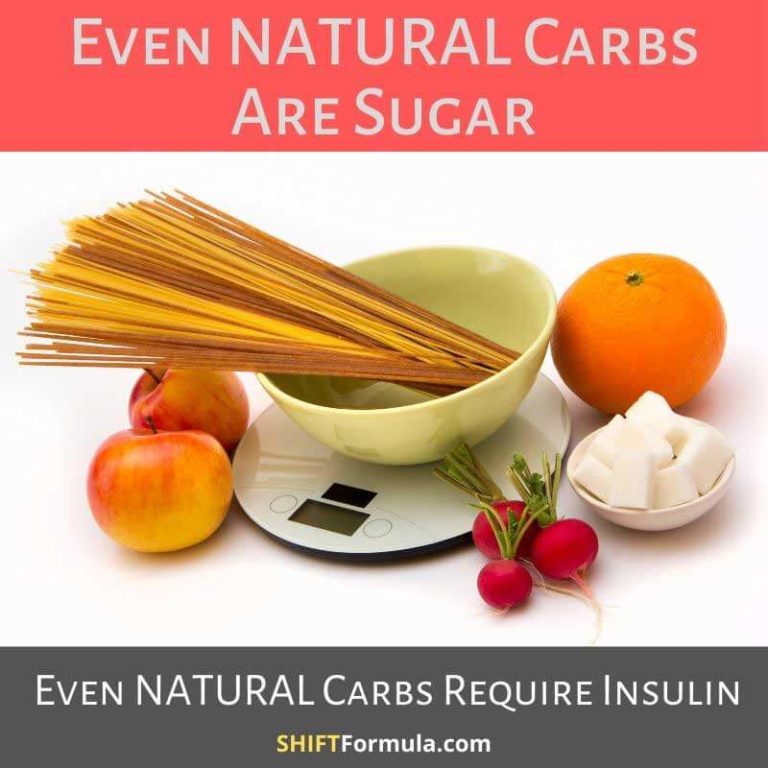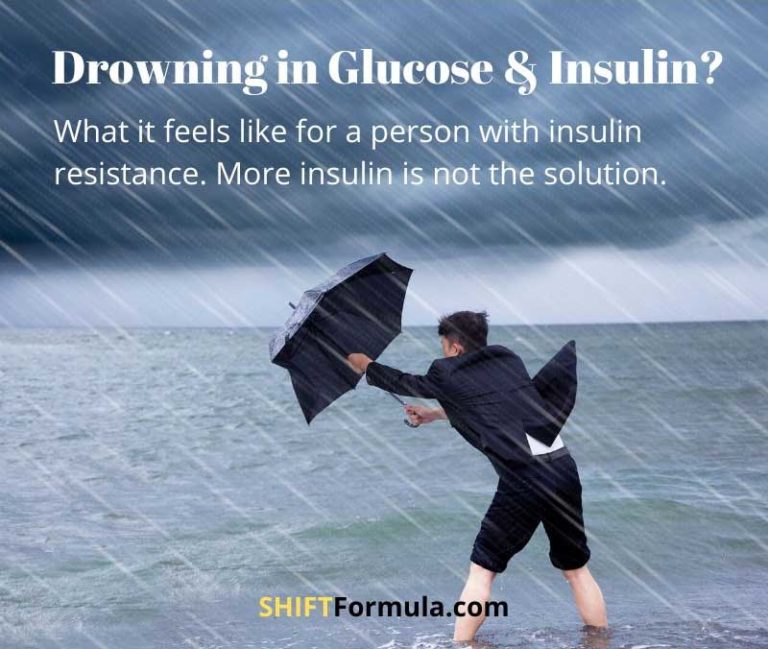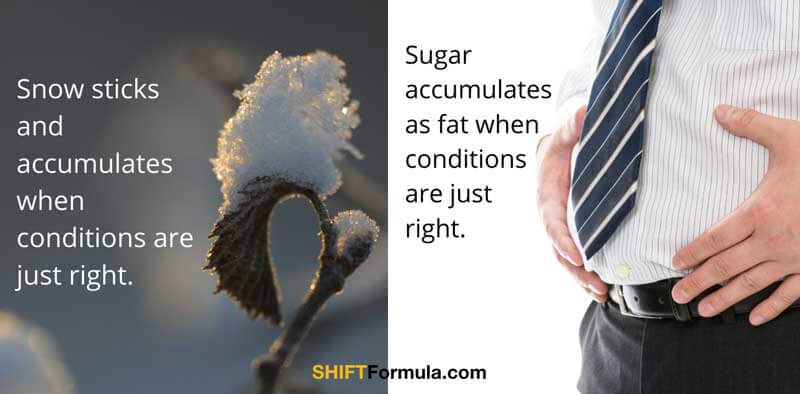What You Will Learn About Reversing Insulin Resistance and Weight Loss:
1.) How Does Insulin Resistance Happen?
2.) How Carbohydrate Increases Insulin Resistance
3.) Why “Healthy” Eating Paves a Path To Weight Gain, Diabetes and More
4.) The Weight Loss Common Thread
5.) Watch The Single Common Thread Linking Diabetes To Weight Gain
6.) . What Insulin Resistance Really Means
7.) Get Your Free Custom Health Plan
8.) How We Accumulate Body Fat
9.) Reverse Insulin Resistance Glossary
10.) Listen To The Podcast – Diabetes & Weight Gain… The Common Thread
How Does Insulin Resistance Happen?
The obesity or weight-related spectrum of conditions has varied labels.
- Insulin Resistance.
- Metabolic Syndrome.
- Hyperinsulinemia.
- Hyperglycemia.
- Diabetes.
- Pre-Diabetes.
- Glucose Intolerance.
- Chronic Inflammation.
- Accelerated Aging.
Insulin Resistance isn’t just for some people. It holds no prejudice. It develops in every body.
So then, how does insulin resistance happen?
The body, over time, grows resistant to insulin to some degree because insulin has been signaling your cells throughout your entire lifetime every time you eat and every time you experience an emotional rise or feel stressed. Insulin becomes especially overly present in a body that has been over-fueled, burdened, or over-loaded with glucose. Glucose is the sugar that foods break down into during digestion.
Ending The Frustration & Confusion of Insulin Resistance
It’s here, at the food itself, where confusion begins.
All foods are comprised of fat, protein, and carbohydrate. It’s one of these three categories that drives insulin resistance far more than any other variable.
Not the fat.
Not the protein.
It’s the Carbohydrate.
How Carbohydrate Increases Insulin Resistance
Insulin is released by the pancreas whenever the amount of sugar rises in the blood which happens whenever we eat carbohydrate.
When. Ever.
Every. Time.
Blood sugar is the glucose from digested carbohydrate that gets deposited into the bloodstream and ends up circulating around the body. Insulin is released by the pancreas in exact proportion to the amount of glucose consumed and ending up in your blood.
The Great Carbohydrate Debate
When is comes to carbohydrate, the great debate usually begins with the word, ‘but’.
But it’s organic.
But it’s gluten-free.
But it’s natural.
But it’s nutrient dense.
But it’s real, whole and unrefined!
Yes. It is all that. But…..
When you boil the thing down to its basic principles, it, carbohydrate, is sugar.
It, carbohydrate, stimulates insulin.
Because it, carbohydrate, is fundamentally, glucose.
Organic glucose.
Gluten-free glucose.
Nutrient dense glucose.
Natural glucose.
Real, whole, unrefined glucose.

Why “Healthy” Eating Paves a Path To Weight Gain, Diabetes and More…
This is why even the purest and most moral of eaters develop insulin resistance and the span of lousy that is part of the glucose-insulin package.
We don’t need to search very far to find a real-life example.
Perhaps a young woman, a tender hearted good-deed doer, led by her conscience to eat morally. Shunning all animal foods, she steadfastly embraces the ethical, sustainable, local plant-based movement.
Having formerly been a conventional foods grazer, eating more processed foods than not, she notices a fortuitous change. Weight loss.
Her physique is slimmer. Her mood peppier. Her conscience clearer.
Fast forward a handful of years and our plant-based eater find herself wondering…
“Is my metabolism slowing? Am I not exercising enough? Why am I developing a ring around my waistline? And why am I always thinking about the next meal?”
Her weight up-shift is concerning. And she hears of others who have dropped significant weight by eating, of all things…..meat.
They privately stepped off the plant platform, just for a time, and achieved terrific weight-loss results.
Moral principle clashes with metabolic principle. The primal human need to look lovely and appear morally above reproach is powerful. She applies the same tactic. You know, just to see if it works. It does.
Does Meat Eating Melt Body Fat?
But it’s right here that misunderstanding develops. Is it the ‘eating meat’ that melts body fat? Can that happen? Why, exactly, would weight loss occur for a young morally conscious woman when she eats meat after years of not?
The Weight Loss Common Thread
Every weight loss occurrence in the world happens because of one variable.
Though seemingly diverse situations,
the Hollywood celebrity endorsing her green drink morning routine…
the middle-aged executive avoiding all white foods….
the tender soul with the guilty conscience eating animal foods for a time…
the newly baptized food purist choosing only organic, real, locally sourced food as part of their attempt to ascend the ladder of blame-less living.
There are as many ways to lose weight as there are people and their diverse preferences. Underlying every weight loss success story is the one common denominator, insulin.
Every. One.
The Insulin Weight Loss Hack
All you need understand is how insulin operates, and you, my friend, can lose weight any way you choose.
Eating plants.
Eating animals.
Eating pretty.
Eating rainbows.
Eating organic.
Eating dirty.
Eating clean.
And every other way of eating in-between.
Watch The Single Common Thread Linking Diabetes To Weight Gain
The Only Thing You Need To Do Is Reduce Your Body’s Insulin Release.
Why?
Insulin is your body’s chief fat accumulation, fat storage, fat lockdown hormone. Each weight loss attempt described above, in its own way, reduced insulin.
Picture a winter scene.
Looking out your Pennsylvania window you see the first snowflakes of the season.
Environmental conditions must be just right for the snowflakes to form and then further right for them to land on the grass and trees…. and ‘stick’. If the weather supports the snow laying on hardscape like driveways and streets, accumulation ensues.
At first the laying snow is barely noticeable. We get distracted. We walk away from the window. We don’t pay attention.
When we look again, the view is quite different. Where, just moments before there was merely a covering, now the snow on the ground is gathering, piling even, in certain places where it sticks more easily. Conditions are ripe for accumulation. And the more consistently it snows, the more accumulation grows.
Sound familiar?
Weight gain is subtle. Imperceptible at first. We get distracted. And even if we are ‘eating by the rules’, whichever ones we’re drawn to or have created for ourselves, when our internal conditions are just right, fat accumulates.
That condition is insulin. And ‘our snow’ is glucose.
accumulate : to gather or pile up especially little by little, to amass

What Insulin Resistance Really Means
Insulin resistance develops, little by little.
Insulin resistance is not what it might sound like. I recall thinking insulin resistance meant a body resists making insulin.
Insulin Resistance Means a Body ‘Resists’ Responding to Insulin.
Insulin is the hormone that signals cells to take in glucose, aka blood sugar.
Cells take in glucose, at insulin’s signal, for one sole purpose: to fuel energy production.
Problem is, if a cell is not under any demand to generate a whole lot of energy and/or the cell already has its requisite amount of glucose fuel, that cell will ‘resist’ insulin’s signal to take in more because it’s already at capacity.
“No thank you. We are full here.”
Cells are intelligent. They “know” when they are full. And they will not take in more glucose than they can handle.
Glucose Overload
We, our cells’ host, are not always so intelligent. We tend to take in far, far more glucose than our body can manage or needs.
Between misleading nutritional directives (get 3-5 servings of healthy whole grains daily, eat more fruits and vegetables, eat six times a day to boost metabolism, eat the colors of the rainbow, nourish yourself, etc….), social pressure (it’s a party! manja!), evolving sedentary lifestyles (computer-desk job, rush hour traffic), ever-accessible eating opportunities ( gastro tours, pre, post, and during sporting events, bake sales, trivial moments raised to celebratory meal status, etc) , and our brain’s primal wiring to seek pleasure (think I need me a dopamine hit), we are hard-pressed to walk away from the buffet known as life.
Knowing internal mechanisms that drive fat accumulation, appetite and its dark cousin, cravings, is critical to well-being and resolving the dreaded spectrum of metabolic syndrome and insulin resistance.
Go to the Natural Sugar Myth.

Insulin Resistance Is Insulin Persistence
Cells begin to resist insulin as a protective measure. And as our body resists insulin more and more, our pancreas persists in producing insulin more and more. Lots of insulin. Now we call our condition hyperinsulinemia. High amounts of insulin.
High amounts of insulin means our body’s internal environment is in fat accumulation mode and ripe for cancer establishment, inflammation, chronic pain progression, accelerated aging, water retention, increasing blood pressure, plus every form of overall lousiness that goes far beyond an expanding waistline.
This is why the term ‘metabolic syndrome’ is used.
Syndrome: a group of symptoms which consistently occur together, or a condition characterized by a set of associated symptoms.
Metabolic: relating to or deriving from the metabolism of a living organism.
“a metabolic disorder”
Metabolism: the chemical processes that occur within a living organism in order to maintain life.
It originates from the Greek word, metabolē, meaning ‘change’.
Change.
This is the key word.
Energy is neither created nor destroyed…only changed.
Food, though many use it for identity, entertainment, creative expression, communication emotion, and other worldly pursuits, is energy.
Food is fuel energy. And the fuel energy that may be trapped as your visceral fat, subcutaneous fat and liver fat is held there against its will by insulin. And the insulin at play in your body is being summoned most powerfully by one specific food category, carbohydrate.
Carbohydrate Foods Digest into Sugar or the Science Term, Glucose.
Glucose, beyond what our body needs at the time of eating, changes or converts into body fat which is simply stored energy.
Body fat ‘sticks’ or is inaccessible for use when conditions are right.
Body fat cannot be accessed for burning when insulin is elevated.
Body fat is controlled by insulin.
Manage insulin, and win.
Learn more about How To Lower Blood Glucose.
How We Accumulate Body Fat
Glucose piles up, little by little, first in your bloodstream. Then distributed throughout your body. Virtually all blood sugar begins from food.
(I say, virtually, because your body generates blood sugar or glucose from both body fat and proteins. Yup. Your body can and will produce its own supply of glucose as needed.)
And all food generated blood sugar first piles up in your bloodstream, and then like the snowplows that push the white stuff into huge piles, insulin pushes blood glucose into adipose tissue where it piles up and accumulates as body fat.
The tender plant eater lost weight when she ate meat, not because of the meat, but because she unknowingly ate less carbohydrate.
All plant food is carbohydrate-based food.
The simple connect-the-dots is that less carbohydrate consumption means less glucose consumption.
The organic rice, quinoa, and beans she’d been relying on were glucose heavy. The meat was glucose-free.
Less Carbohydrate Equals Less Insulin Equals Weight Loss
Less carbohydrate/glucose-based food means less blood sugar. Which means less insulin secreted. Less insulin secreted means body fat is no longer trapped. Less insulin means body fat is free for use. Less insulin means fat burning enzyme, lipase, is in full production again. Less insulin means more body fat burning.
THAT is how the tender gal ‘lost weight’. Her body was enabled to use body fat for fuel. She lessened the intake of glucose which allowed her body to start ‘dining in’ on her onboard fuel, body fat.
It really had nothing to do with the meat. It had everything to do with what she didn’t eat.
The Science of Insulin and Weight Loss
If she had known the science of insulin, she could have managed her weight issue while maintaining her moral eating protocol.
SHIFTing is basic science. It is applicable to any and every food philosophy. It is the underlying basic principles of metabolism.
To be insulin resistant is to reside in an insulin persistent state.
An insulin persistent state is a cancer supporting, fat storing, plaque forming, blood sugar soaring, inflammation roaring, and cravings and pain enduring existence.
To break the resistance demands persistence of another kind.
- Persistent low-glucose food choices.
- Persistent periods of minimal insulin release.
- Persistent right action.
The Magic of Insulin Suppression
Insulin suppression can be performed by any one.
When insulin is high, your body shifts into fat accumulation, sugar burning, fat storage mode.
When insulin is low, your body shifts into fat dissipation, fat burning, fat release mode.
You decide which mode you want to be in.
Reverse Insulin Resistance Glossary
Insulin Resistance. Body tricked into over-producing insulin due to cell unresponsiveness. Cells resist insulin’s signal to allow glucose in as a protective measure. Pancreas compensates by releasing more and more insulin.
Metabolic Syndrome. The spectrum of symptoms and conditions all associated with one another. Weight Gain. Elevated Blood Pressure. Fluid Retention. Neuropathy. Atherosclerosis. Cancer. Alzheimer’s. Diabetes.
Hyperinsulinemia. High levels of insulin due to some degree of insulin resistance. High levels of insulin occur in both slim and stout individuals. Those with higher levels of insulin are at significant greater risk for developing cancer, heart disease, and dementia. Glucose and insulin drive the Big 3.
Hyperglycemia. High levels of blood sugar due to some degree or combination of the following variables: carbohydrate-lopsided diet, over-fueling, under-activity, insulin resistance, under-functioning pancreas, depleted or damaged beta cells.
Diabetes. Medical label for higher than optimal blood sugar levels. Sugar-glucose builds up in the blood rather than being distributed around the body.
Pre-Diabetes. Medical label for blood sugar levels rising near the diabetic blood glucose threshold value.
Glucose Intolerance: Glucose in the blood, blood sugar, is higher than optimal due to poorly functioning insulin or excess glucose/carbohydrate consumption.
Inflammation: Condition of marked fluid and heat generated by immune system response to an irritant. AGEs are irritants that cause inflammation. (Advanced Glycated Endproducts or sugar damaged proteins) Where there is elevated glucose and insulin there is elevated inflammation.
Aging: Term used to describe time-driven deterioration. Glucose and insulin accelerate aging as AGEs accumulate more readily and steadily.
Weight Gain. Predictable consequence of glucose intake aka carbohydrate and subsequent insulin response. However, it is critical to realize that some bodies are more prone to storing excess glucose as body fat (weight gain) while others are more prone to breaking down excess glucose and dispersing throughout the body (AGE formation) where they adhere to and corrupt delicate tissue such as nerves, joints, and brain.
Listen To The Podcast Version Of This Article: Diabetes & Weight Gain… The Common Thread
Listen to our other Insulin Suppression Podcasts – Listen Here.

About Barbara McDermott
Regarded as America's #1 Insulin Suppression Coach, Barbara is the co-founder of SHIFT Health & Wellness Solution, and the best-selling author of the groundbreaking book, ‘FOOD B.S.’, With SHIFT, Barbara brings common sense to nutrition, weight loss and health gain. Her refreshing, no nonsense approach to uncovering the truth using non-negotiable rules of science demystifies food and how to defeat chronic disease once and for all.




No comments yet.